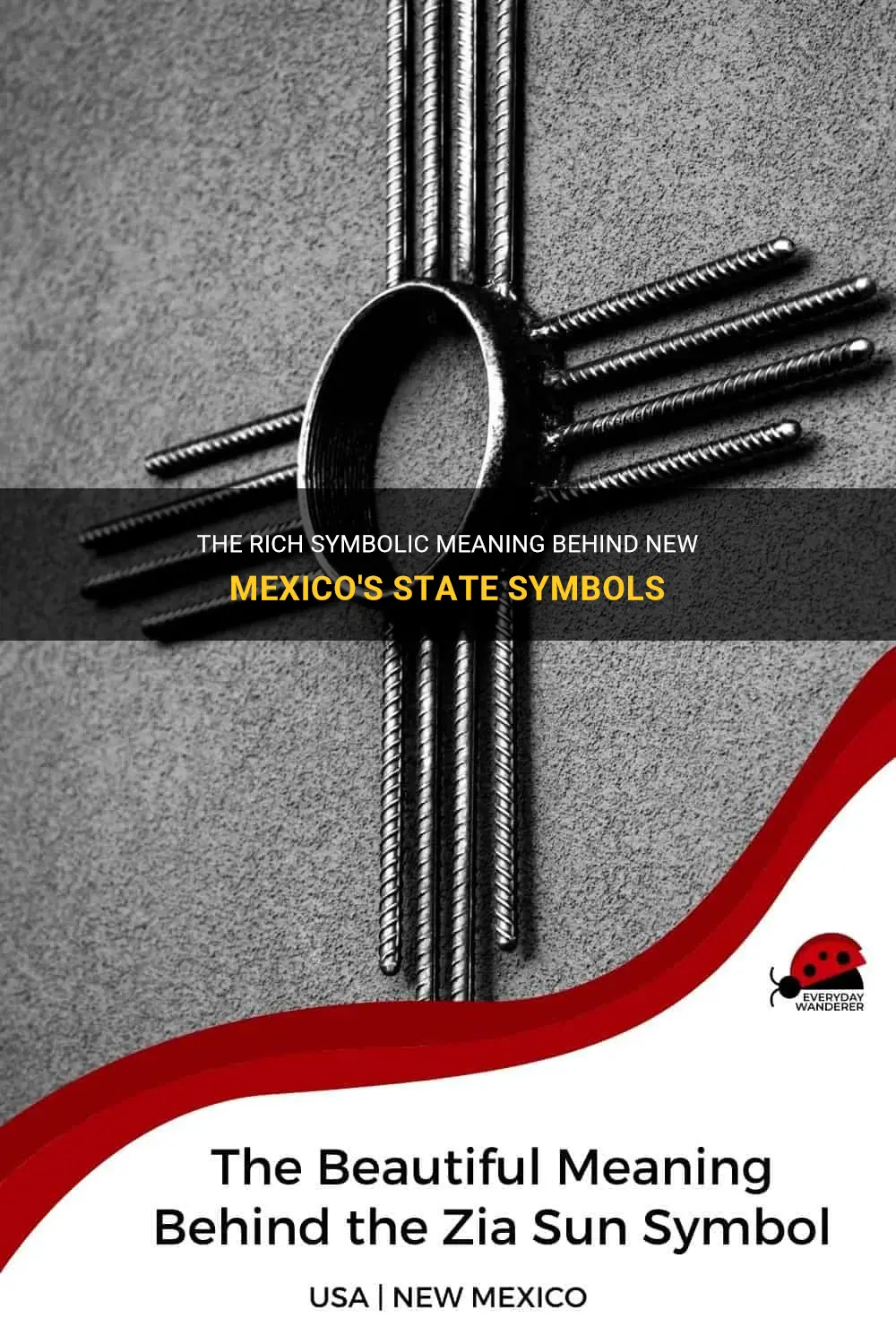
New Mexico, the Land of Enchantment, is a state full of rich cultural heritage and captivating natural beauty. From its deep-rooted Native American traditions to its vibrant Hispanic influence, New Mexico's symbols reflect the unique character and history of the state. The symbols of New Mexico provide a glimpse into the diverse and fascinating tapestry of this Southwestern gem. Whether it's the Zia symbol representing the four corners of the earth or the Roadrunner symbolizing speed and resilience, each emblem tells a story and holds a special meaning to the people of New Mexico. Join me as we explore the significance of these symbols and uncover the magic that makes New Mexico truly enchanting.
What You'll Learn
- What is the official state symbol of New Mexico and what does it represent?
- Are there any other symbols that are commonly associated with New Mexico and what do they symbolize?
- How has the meaning behind New Mexico's state symbols evolved over time?
- Are there any Native American symbols or meanings incorporated into New Mexico's state symbols?
- Are there any lesser-known symbols or meanings associated with New Mexico that are not widely recognized?

What is the official state symbol of New Mexico and what does it represent?
The official state symbol of New Mexico is the Zia Sun Symbol, which is a graphic representation of a sun with four rays in each of the four cardinal directions. This iconic symbol holds great significance for the state and its people.
The Zia Sun Symbol represents the ideals of the Zia Pueblo, one of the Native American tribes of New Mexico. The Zia people believe in the sacred number four, which is represented by the four rays of the sun symbol. The number four represents the four directions, the four seasons, the four times of day (morning, noon, evening, and night), and the four stages of life (childhood, youth, adulthood, and old age). It is considered a number of great spiritual and cultural importance, symbolizing harmony and unity.
The Zia Sun Symbol was officially adopted as the state symbol of New Mexico in 1925. It is prominently featured on the state flag, as well as on various official seals and emblems. The symbol represents not only the Zia Pueblo but also the shared heritage and values of all the people of New Mexico.
The Zia Sun Symbol is a proud representation of the state's unique cultural heritage and serves as a reminder of the importance of balance, harmony, and interconnectedness. It is often seen as a symbol of hope, optimism, and the bright future of the state. The image of the sun also reflects the sunny climate and clear skies that New Mexico is known for.
The Zia Sun Symbol has become a recognizable icon not only in New Mexico but also throughout the United States. It is often used in art, jewelry, and other forms of expression, representing the spirit and character of the state.
In conclusion, the Zia Sun Symbol is the official state symbol of New Mexico and represents the ideals and beliefs of the Zia Pueblo. It symbolizes the sacred number four and embodies the values of harmony, unity, and balance. This iconic symbol is a source of pride for the people of New Mexico and serves as a reminder of the state's rich cultural heritage.
What Does the Car with Arrow Symbol Mean?
You may want to see also

Are there any other symbols that are commonly associated with New Mexico and what do they symbolize?
New Mexico, also known as the Land of Enchantment, is a state rich in history, culture, and symbolism. While the most well-known symbol of New Mexico is the Zia symbol, there are several other symbols that are commonly associated with the state.
One of the symbols commonly associated with New Mexico is the Roadrunner. The roadrunner is the state bird of New Mexico and is known for its speedy nature. The roadrunner symbolizes the spirit of the state and its ability to adapt and thrive in the desert landscape. It also represents resilience and resourcefulness, traits that are highly valued in New Mexican culture.
The turquoise stone is another symbol commonly associated with New Mexico. Turquoise has been used in Native American jewelry and artwork for centuries and is deeply ingrained in the state's history and heritage. The stone symbolizes protection, healing, and good fortune. It is believed to bring clarity of thought and spiritual well-being.
The Kokopelli is another symbol commonly associated with New Mexico. Kokopelli is a fertility deity often depicted as a humpbacked flute player. He is considered a trickster and a storyteller, and his image can be found in Native American rock art throughout the Southwest. The Kokopelli symbolizes fertility, joy, and the celebration of life.
In addition to these symbols, the Zuni sunface is also commonly associated with New Mexico. The Zuni sunface is a symbol of the sun and is used in Zuni Pueblo pottery, jewelry, and other artwork. The sunface symbolizes life, warmth, and fertility, and is considered a sacred symbol in Zuni culture.
Another symbol associated with New Mexico is the Cactus. The cactus is a plant that is able to thrive in the harsh desert conditions of the state. It symbolizes endurance, resilience, and the ability to withstand adversity. The cactus is also a symbol of protection and strength.
These symbols, along with the Zia symbol, help to represent the rich history, culture, and spirit of New Mexico. They reflect the unique landscape, heritage, and values of the state, making them an important part of its identity. Whether displayed in artwork, jewelry, or other forms, these symbols serve as a reminder of the beauty and significance of New Mexico.
Unraveling the Mysterious Meaning Behind Prince's Purple Rain Symbol
You may want to see also

How has the meaning behind New Mexico's state symbols evolved over time?
The state symbols of New Mexico hold great significance in representing the history, culture, and natural beauty of the state. Over time, the meaning behind these symbols has evolved, reflecting the changing perspectives and values of the people of New Mexico.
One of the most recognizable symbols of New Mexico is the Zia Sun Symbol. The symbol features a circle with four groups of rays extending in four directions. Each group consists of four rays, representing the four seasons, four directions, four stages of life, and four sacred obligations. The Zia Sun Symbol is a sacred symbol of the Zia Pueblo people, and it was adopted as the state symbol in 1925. Today, the Zia Sun Symbol represents unity, harmony, and the sacredness of life.
Another important state symbol is the Yucca Flower. The Yucca Flower was designated as the state flower in 1927. It is a hardy plant that is able to survive in the arid and harsh conditions of New Mexico. The Yucca Flower symbolizes beauty, resilience, and adaptability, qualities that are characteristic of the people of New Mexico.
The state bird of New Mexico is the Roadrunner, which was officially recognized in 1949. The Roadrunner is known for its agility, speed, and resourcefulness. It has the ability to adapt to various habitats and overcome obstacles, making it a symbol of resilience and determination. In addition, the Roadrunner is deeply rooted in the Native American and Hispanic cultures of New Mexico, where it is considered a symbol of good luck.
The Chile Pepper is another emblematic symbol of New Mexico. The Chile Pepper was proclaimed as the official state vegetable in 1965. New Mexico is renowned for its spicy and flavorful chile peppers, which are integral to the state's cuisine and cultural identity. The Chile Pepper represents the rich agricultural heritage and vibrant culinary traditions of New Mexico.
Throughout the years, the meaning behind these state symbols has expanded to encompass broader themes and values. They no longer just represent the natural beauty and resources of New Mexico, but also its cultural diversity, resilience, and community spirit. The symbols have become a source of pride and identity for the people of New Mexico, serving as reminders of their heritage and connection to the land.
In conclusion, the meaning behind New Mexico's state symbols has evolved over time to reflect the changing perspectives and values of the people. The symbols now represent not only the natural beauty and resources of the state but also its cultural diversity, resilience, and community spirit. They are a source of pride, identity, and connection to the land for the people of New Mexico.
Deciphering the Meanings Behind Modem Symbols: A Guide to Understanding Internet Connectivity
You may want to see also

Are there any Native American symbols or meanings incorporated into New Mexico's state symbols?
New Mexico, known as the Land of Enchantment, is rich in Native American history and culture. The state's diverse population consists of numerous Native American tribes, including the Navajo, Apache, Pueblo, and others. With this strong Native American influence, it's not surprising that New Mexico's state symbols also incorporate Native American symbols and meanings.
One of the most notable state symbols of New Mexico is the state flag. Designed in 1920, the flag features a vibrant yellow background with a red sun symbol in the center. The red sun symbol, known as the Zia symbol, holds great spiritual significance for the Zia Pueblo tribe. It consists of a circle with four groups of four rays radiating from it in four directions. The number four represents the four seasons, four points of the compass, four stages of life, and the four sacred obligations of the Zia people: a strong body, a clear mind, a pure spirit, and a devoted heart.
The Zia symbol has since become an iconic representation of New Mexico and is widely recognized and respected throughout the state. It symbolizes the state's Native American heritage and the values of harmony, community, and respect for the Earth.
Another state symbol that incorporates Native American symbolism is the state flower, the yucca. The yucca plant has been used by Native Americans for various purposes for centuries. It has both practical and spiritual significance, providing food, medicine, and materials for weaving baskets and making cordage. The yucca's tall stalk with white, bell-shaped flowers is a symbol of beauty, resilience, and adaptability, qualities that are valued in Native American culture.
New Mexico's state bird, the roadrunner, also holds cultural significance for Native Americans. The roadrunner is admired for its speed, agility, and resourcefulness. In Native American folklore, the roadrunner is often portrayed as a clever and cunning character, outsmarting its enemies with its quick thinking. This bird is considered a symbol of protection, good fortune, and the ability to adapt to changing circumstances.
Furthermore, the state nickname, "Land of Enchantment," reflects the spiritual and mystical qualities often associated with Native American cultures. It refers to the state's natural beauty, cultural diversity, and the sense of awe and wonder that many experience when visiting New Mexico. Native American tribes have a deep connection to the land and view it as sacred, emphasizing the importance of maintaining a harmonious relationship with nature.
In conclusion, New Mexico's state symbols pay homage to the state's Native American heritage. From the Zia symbol on the state flag to the yucca as the state flower and the roadrunner as the state bird, these symbols incorporate Native American symbols and meanings that reflect the values and beliefs of the state's indigenous cultures. They serve as a constant reminder of the deep roots and rich traditions that have shaped New Mexico's history and cultural identity.
The Deep Symbolism of the Sicilian Three-Legged Structure: The Hidden Meanings Unveiled
You may want to see also

Are there any lesser-known symbols or meanings associated with New Mexico that are not widely recognized?
New Mexico, also known as the Land of Enchantment, is a state rich in history, culture, and symbolism. While many people are familiar with the iconic symbols of New Mexico such as the Zia symbol and the Roadrunner, there are several lesser-known symbols and meanings associated with the state that are not widely recognized. These symbols represent the unique aspects of New Mexico's heritage and add to its mystical allure.
One lesser-known symbol associated with New Mexico is the Pottery of the Pueblo Indians. The Pueblo Indians have a long history of creating beautiful pottery that is not only visually striking but also carries deep symbolism. Each pottery piece is carefully crafted by hand using traditional methods passed down through generations. The patterns and designs on the pottery often represent important cultural or spiritual beliefs. For example, geometric shapes may symbolize different elements of nature, while animal motifs can represent guardians or spiritual guides.
Another lesser-known symbol of New Mexico is the Mimbres culture's Black-on-White ceramic art. The Mimbres people were a Native American culture that thrived in the region from around 1000 to 1150 AD. Their ceramic art is renowned for its intricate designs depicting animals, humans, and mythical beings. They used black pigments on a white background to create bold and visually striking imagery. The Mimbres pottery often tells stories or legends, carrying the rich history of the region.
The Milagro, or "miracle," charm is another symbol deeply rooted in New Mexico's culture. Milagros are small, metal charms that are often shaped like body parts, animals, or objects. These charms are traditionally used as offerings or prayers to saints, asking for protection or healing. Milagros are often found in churches or placed on roadside shrines and are believed to have the power to grant miracles. They are a physical representation of the faith and hope that is deeply ingrained in New Mexico's culture.
The Serpent and the Eagle are two symbolic creatures that are associated with the ancient beliefs of the region. The serpent is a powerful symbol of rebirth and renewal in many cultures around the world. In New Mexico, the serpent is often depicted in art and pottery, representing a connection to nature and the cycles of life. The eagle, on the other hand, is a symbol of strength, courage, and freedom. It is often associated with spiritual and divine aspects, representing a connection to the heavens.
The Zozobra, also known as "Old Man Gloom," is a unique New Mexican tradition that symbolizes the release of negativity and the start of something new. Every year in Santa Fe, a large puppet of Zozobra is created and burned at the annual Burning of Zozobra event. People write down their worries and fears and attach them to the puppet before it is set on fire. The burning of Zozobra is a symbol of letting go of negativity and starting fresh.
In conclusion, while the Zia symbol and the Roadrunner are well-known symbols associated with New Mexico, the state is also rich in lesser-known symbols and meanings. Symbols such as the Pottery of the Pueblo Indians, Mimbres ceramic art, Milagros, the Serpent, the Eagle, and the Zozobra all add to the cultural and spiritual tapestry of New Mexico. Exploring these lesser-known symbols can deepen one's understanding and appreciation of the Land of Enchantment.
Unlocking the Secrets of Dreidel Symbols and Meanings
You may want to see also
Frequently asked questions
The New Mexico state flag features a red sun symbol on a yellow background. The red sun symbolizes the beauty of the state's landscapes and the unique desert climate. The yellow background represents the abundance of sunshine that New Mexico enjoys throughout the year.
The Zia symbol is a sacred symbol to the Zia Pueblo Native American tribe, and it holds deep meaning for the state of New Mexico. The symbol consists of a circle surrounded by four groups of four rays, totaling 16 rays in all. Each group of rays represents different aspects of life, such as the four seasons, the four directions, the four stages of life, and the four virtues of life.
Each ray of the Zia symbol has its own meaning. The four rays represent the four cardinal directions: north, south, east, and west. They also symbolize the four seasons: spring, summer, fall, and winter. Additionally, the rays represent the four stages of life: childhood, youth, adulthood, and old age. Lastly, the rays embody the four virtues: love, faith, hope, and courage.
The New Mexico state flag was officially adopted in 1925. The design of the flag was inspired by a symbol found on a 19th-century water jar discovered in Zia Pueblo. The Zia symbol was chosen to represent the state's Native American heritage and its deep connection to the land. The yellow and red colors were selected to honor Isabella I of Castile, the queen who sponsored Christopher Columbus's journey to the Americas.
The Zia symbol is not copyrighted or trademarked, as it has deep cultural and religious significance to the Zia Pueblo tribe and is considered a sacred symbol. However, it is generally respected and recognized as a symbol of New Mexico and is often used to represent the state in official capacities.



















